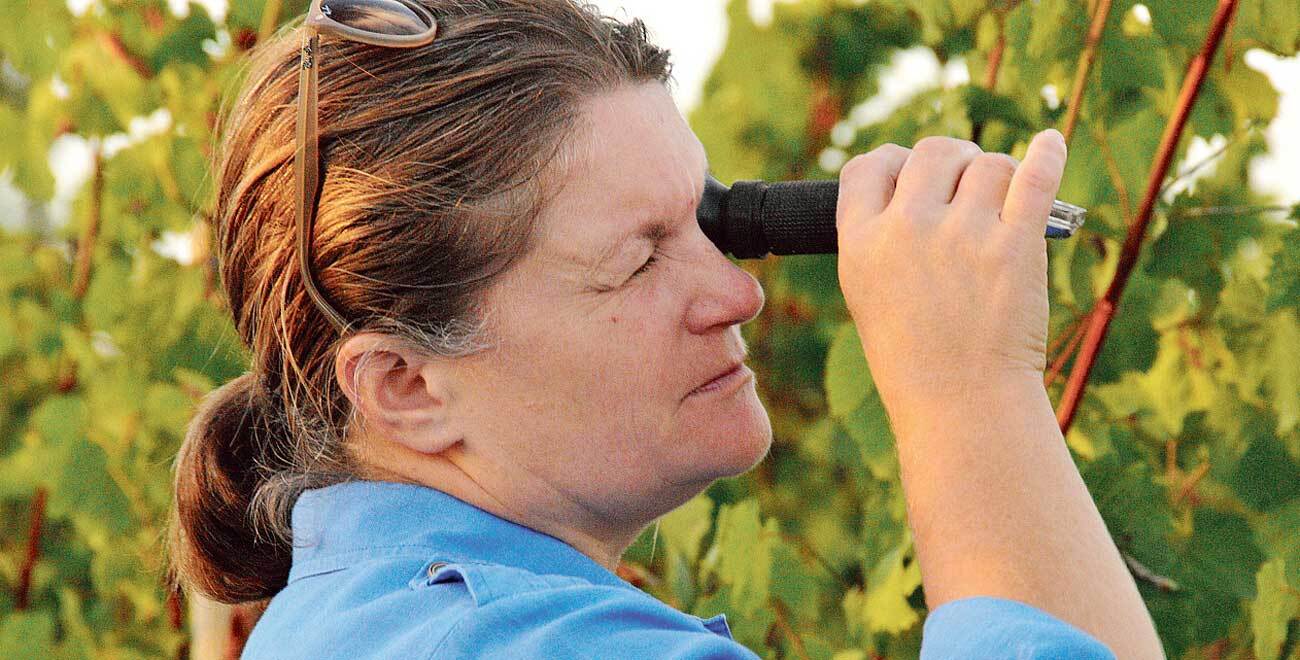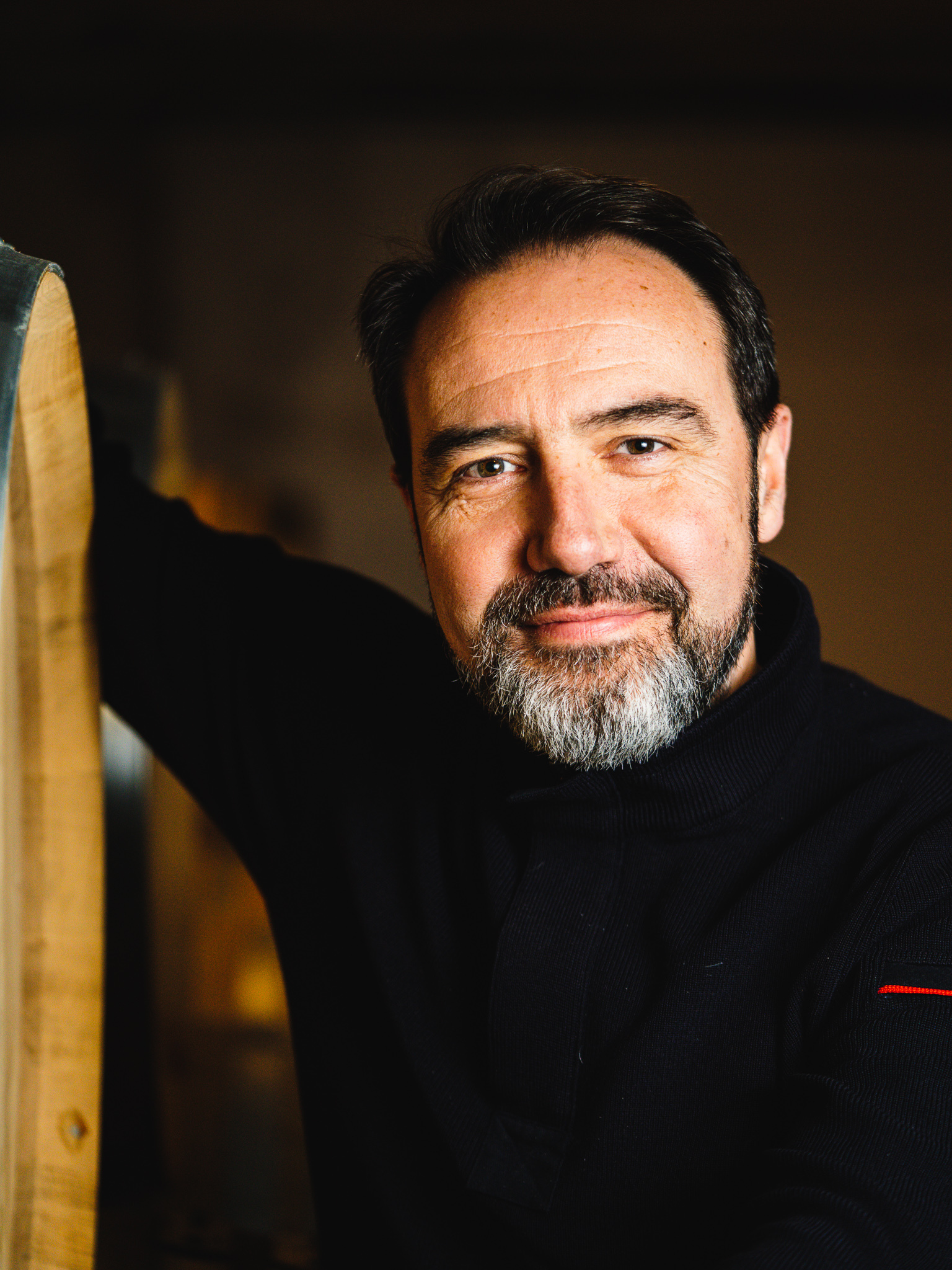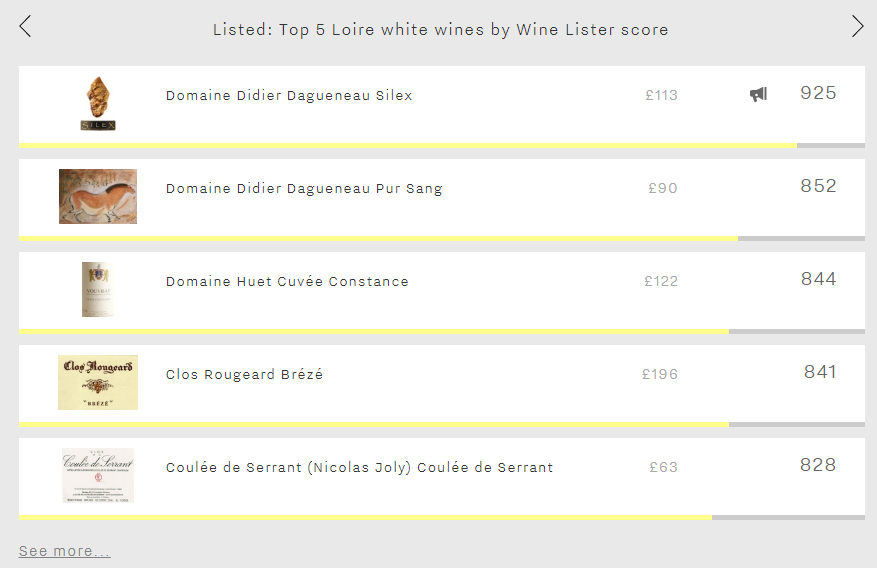Second-generation owner and winemaker of her estate in Anjou: “The important thing is to feel alive”.
For the 13th interview in Le Figaro Vin’s series we remain in Savennières in the Loire to meet Tessa Laroche, #38. One of France’s greatest winemakers, hidden away in one of the country’s tiniest appellations, Savennières Roche aux Moines, she will celebrate 20 years at the helm of her estate in 2023.

Her parents bought the property, whose wine-growing origins date back to the Middle Ages, in 1981. At that time the wine was still sold in barrels, not bottles. With each passing vintage they succeeded in converting the neighbourhood. Tessa’s mother, Monique Laroche, who passed away in 2020, was the driving force who played a major part in establishing the region’s viticultural reputation.
Her core operation remains the iconic wine of the estate, turning out between 30,000 and 40,000 bottles a year, but in recent years Tessa Laroche has branched out with a new wine, Le Berceau des Fées. This is made from young vines and matured in vats instead of barrels, while her reds, made from Cabernet Franc, display a vivacity rarely found elsewhere. Though her terroir remains her greatest love, not a day goes by without a glass of champagne. As she is fond of pointing out: “The important thing is to feel alive”.
Le Figaro Vin: How does it feel to be crowned a winemaking champion?
Tessa Laroche: I am not a champion, because it is impossible to go it alone. I am just a winemaker. I have a passion, I try to do the best that I possibly can, together with all the colleagues who work with me on the estate.
Who is your mentor?
My mother tops the list, but I would add Odilon de Varine, Charles-Emmanuel Girard, and Richard Leroy (respectively cellar master in Champagne, oenologist in the Loire Valley, and legendary winemaker in Anjou, ed.).
Is wine a team sport?
Yes, without a team you cannot function. There is always a captain, as in any sport or as there is on a ship. The prerequisites are that my team must enjoy food and wine, must have a good sense of humour, and must be happy. The wine we make is good and full of life, so we have to be in harmony!
What is the key to making a good wine? The terroir or the winemaker?
You cannot achieve the necessary level of complexity without the terroir. Without being a megalomaniac, I am lucky to have one of the finest terroirs in existence. That said, all of us are passionate about what we do and, no matter what, our love is reflected in the wine.
To what do you owe your success?
To this wonderful place, and to my parents, who came to establish themselves here. My team has been here for 15 years. Without them I would never have got this far.
The king of grape varieties?
Chenin. It is the best grape variety in the world, with its potential for total success or abject failure. You have to learn how to tame it, growing small yields and small bunches of grapes. But you can have so much fun with it, making sparkling wines, dry wines, sweet wines…you have to know how to manage it, rather like with a horse. If you give it its head it probably won’t be that good. Just now my preference is for dry wines, but the sweet wines are coming back into favour.
Your favourite wine?
Roche aux Moines 2001, my very first wine.
Your favourite vintage?
2019, which I like hugely right now, just like the 2017. But it’s constantly evolving.
If your wine was a person, who would it be?
Just like your dog, your wine takes on your appearance. My wine looks like joie de vivre because I try not to transfer my anxiety to it.
What are the best circumstances in which to taste your wine?
You should be relaxed, at the end of the morning, or after a productive day, sitting in the garden or in front of the fireplace.
Who is your strongest competition in the Loire?
For all of us here Richard Leroy is the master. We even call him God. He is always exchanging ideas, part of the conversation. He loves to share his knowledge. We have to remember that we are all just passing through and it is essential to engage with each other. There is a real solidarity in Anjou, and no one works in isolation. That is probably why the region attracts so many new establishments.
Have you ever thought about chemically enhancing yourself, or your wine?
No, that has never occurred to me. I don’t wear make-up, so why not keep my wine natural too?
Is your family proud of you?
We are siblings and everyone is delighted by the continuity of the estate.
What has been your most innovative strategy in the vineyard and in the cellar?
To get the best grapes depending on the vintage. You have to reinvent yourself every year. However, there is nothing more difficult if you are French!
Who would be your ideal successor on the podium?
God alone knows. I have six nephews and nieces. The choice has to be obvious and, above all, not put pressure on anyone. As things stand, I am in no hurry.
Owner of Domaine Belargus: “I have a bit of a PSG syndrome”.
Figaro Vin’s 39th top French winemaker, Ivan Massonnat creates sumptuous wines on Savennières’ exceptional terroir.

In the Loire valley, on one of Anjou noir’s finest terroirs, Ivan Massonnat is fulfilling his long-lasting dream of producing excellent Chenins from Savennières. At the Belargus estate, born in 2018 with the purchase of the Pithon-Paillé estate, 24 hectares of vines are biodynamically grown in a parcel-based approach inspired by the Burgundian “climates”. Named in tribute to the rare cuvée once made by Jo Pithon – the “Belargus des Treilles” – Belargus is also the name of a small blue butterfly that’s exceedingly rare at this latitude but can be found on the Coteau des Treilles terroir.
Le Figaro Vin. – How does it feel to be crowned a winemaking champion?
Ivan Massonnat. – I don’t consider myself to be a champion. One part of me feels like a wine amateur that’s made it and is living the dream, the other like a producer that makes his wine and takes decisions.
Have you been training for long?
Yes, since my childhood, without even realising it. My passion for vines stems from my grandfather’s vines, and I’ve trained by being in contact with real champions, of the Burgundian kind.
Who is your coach?
Jo Pithon, who’s been by my side every day throughout this adventure, with 40 vintages under his belt. I have a few other mentors, such as Thibault Liger-Belair and Philippe Pacalet in Burgundy. It’s by their side that I learnt to trust myself. There’s Pierre Amoreau from Château Le Puy, who taught me a lot. Among those who inspire me, there’s also Anselme Selosse. His approach goes far beyond that of a winemaker, he’s a true philosopher. At 45 years old, I completely changed my life, shifting towards a career I knew to be difficult. When I see a man like him, I know I’ve done the right thing.
Is wine a team sport?
Yes, definitely. I spend my time saying so. There are some people who are often cast aside, especially in the vineyard, but on my estate, it’s the opposite. You need great talent, with each individual excelling in their specialty. The members of my team are sharp and well-suited to their roles. I have the PSG syndrome; I don’t want people working in silos. If everyone isn’t aware of the whole, we cannot accomplish anything. Good ideas sometimes come from across the playing field. For me, the concept of a rugby team is the best model there is.
What is the key to making a good wine? The terroir or the winemaker?
I have a vision of making wine with a sense of place, and not all places are created equal. That being said, a good-for-nothing from the finest place will not make a great wine! I don’t believe that a winemaker is a magician.
To what or to who do you owe your success?
To all those who believed in me, my closest circle, who didn’t view my project as a pipe dream. There are also those who told my story, as well as the clients. No project can bring people together the way wine does. Each link in the chain has been important. I never imagined things would happen so fast, and the seeds would take root.
Is your family proud of you?
Yes, and very happy for me. My family has made a lot of sacrifices, but it was worth it in the end.
Your favourite colour?
I started with reds, but today I like whites just as much.
The king of grape varieties?
Chenin! It has a lot of character and concentrates a lot of different traits.
Your favourite wine?
The Coteau des Treilles, which I just call Les Treilles.
Your favourite vintage?
Probably 1989, for the reds. It’s the one I’ve had the most opportunities to enjoy.
If your wine were a person, who would they be?
Me. A profound part of a winemaker’s personality finds its way into the wine they make.
What’s the best way to enjoy it?
In good company.
Have you already thought about chemically enhancing yourself, or your wine?
No.
If you had to put a price on your estate, what would it be?
I’m not planning to. This is a 100-year project, and I don’t know what value it will have in a century’s time!
Who is your strongest competition in Anjou?
I don’t view competition that way, nor do I consider my neighbours as opponents. What impresses me is team play. My adversary could be the beer or alcohol-free drinks industries. When I see people with a waning interest in wine, I feel like we’ve missed the boat somewhere along the line.
What has been your most innovative strategy in the vineyard and in the cellar?
My most innovative idea in the region was to break the glass ceiling. What has defined Belargus is the conviction that this region produces some of France’s finest white wines and that they shouldn’t be sold at a discount. It was a risk, but in line with what I was doing. Les Treilles has been the proof of this: a 100 euro-wine from Anjou. This was completely unheard of.
Who would be your ideal successor on the podium?
I don’t know yet. I don’t want to impose this on my children. Nevertheless, one thing is certain: I will not last forever. What will remain is the terroir. My only wish is that my successor be passionate.
Stretching from the Atlantic coast in the West to Pouilly-sur-Loire in the East, the Loire Valley extends half way across France, and is home to some of the country’s great white wines. Reflecting the diversity of the region, the Loire’s top five whites comprise two dry Sauvignon Blancs, two sweet Chenin Blancs, and a dry Chenin Blanc. However, whilst these wines are diverse in style, they share several key characteristics – they are all produced biodynamically, in small quantities, and by cult winemakers.

Leading the way are two Pouilly-Fumés from Domaine Didier Dagueneau – Silex and Pur Sang. One of Wine Lister’s Buzz Brands, Silex achieves excellent scores in each of Wine Lister’s three categories. However, it enjoys particularly strong brand recognition, present in 39% of the world’s best restaurants and receiving on average over 4,000 searches each month on Wine-Searcher. Pur Sang achieves its best score in the Economics category, thanks to strong price performance – with a three year CAGR of 14% and a six month growth rate of 13%.
Moving West to Vouvray, Domaine Huet Cuvée Constance comes next. Produced only in great vintages, this botrytised Chenin Blanc has the best Quality score of the group (981), and the 14th highest of all white wines on Wine Lister.
Continuing further down the valley, Clos Rougeard Brézé is in fourth place. The most expensive wine of the group, it has a remarkable three year CAGR of 33%, confirming that it is a wine on a strong upward trajectory. The fifth wine is Nicolas Joly’s Coulée de Serrant. Produced in the most westerly appellation of the group – Savennières Coulée de Serrant – Brand is its strongest category, present in 31% of top establishments.
Don’t forget – if you’re not yet a subscriber to Wine Lister, you can still fully explore this week’s five Listed wines, and those for the previous four weeks, via the homepage.


